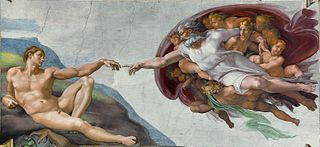
Creationism is the religious belief that nature, and aspects such as the universe, Earth, life, and humans, originated with supernatural acts of divine creation. In its broadest sense, creationism includes a continuum of religious views, which vary in their acceptance or rejection of scientific explanations such as evolution that describe the origin and development of natural phenomena.

A clade, also known as monophyletic group, is a group of organisms that consists of a common ancestor and all its lineal descendants, and represents a single "branch" on the "tree of life". Rather than the English term, the equivalent Latin term cladus is often used in taxonomical literature.

Evolution is change in the heritable characteristics of biological populations over successive generations. These characteristics are the expressions of genes that are passed on from parent to offspring during reproduction. Different characteristics tend to exist within any given population as a result of mutation, genetic recombination and other sources of genetic variation. Evolution occurs when evolutionary processes such as natural selection and genetic drift act on this variation, resulting in certain characteristics becoming more common or rare within a population. It is this process of evolution that has given rise to biodiversity at every level of biological organisation, including the levels of species, individual organisms and molecules.
Evolutionism is a term used to denote the theory of evolution. Its exact meaning has changed over time as the study of evolution has progressed. In the 19th century, it was used to describe the belief that organisms deliberately improved themselves through progressive inherited change (orthogenesis). The teleological belief went on to include cultural evolution and social evolution. In the 1970s the term Neo-Evolutionism was used to describe the idea "that human beings sought to preserve a familiar style of life unless change was forced on them by factors that were beyond their control".

John Maynard Smith was a British theoretical and mathematical evolutionary biologist and geneticist. Originally an aeronautical engineer during the Second World War, he took a second degree in genetics under the well-known biologist J. B. S. Haldane. Maynard Smith was instrumental in the application of game theory to evolution with George R. Price, and theorised on other problems such as the evolution of sex and signalling theory.

Paleontology, sometimes spelled palaeontology is the scientific study of life that existed prior to, and sometimes including, the start of the Holocene Epoch. It includes the study of fossils to determine organisms' evolution and interactions with each other and their environments. Paleontological observations have been documented as far back as the 5th century BC. The science became established in the 18th century as a result of Georges Cuvier's work on comparative anatomy, and developed rapidly in the 19th century. The term itself originates from Greek παλαιός, palaios, "old, ancient", ὄν, on, "being, creature" and λόγος, logos, "speech, thought, study".

Old Earth creationism is a form of creationism which includes gap creationism, progressive creationism, and theistic evolution. Old Earth creationism is typically more compatible with the scientific evidence on the issues of physics, chemistry, geology, and the age of the Earth, in contrast to young Earth creationism.

A humanoid is something that has an appearance resembling a human without actually being one. The earliest recorded use of the term, in 1870, referred to indigenous peoples in areas colonized by Europeans. By the 20th century, the term came to describe fossils which were morphologically similar, but not identical, to those of the human skeleton.

Theistic evolution, theistic evolutionism, evolutionary creationism, divine direction, or God-guided evolution are views that regard religious teachings about God as compatible with modern scientific understanding about biological evolution. Theistic evolution is not in itself a scientific theory, but a range of views about how the science of general evolution relates to religious beliefs in contrast to special creation views.
Evolution is the change in heritable traits of biological organisms over successive generations due to natural selection and other mechanisms.

E.V.O.: Search for Eden is a side-scrolling action video game developed by Almanic Corporation and published by Enix for the Super Nintendo Entertainment System. Released in 1992 for Japanese audiences, the game was later translated and released in North America in 1993. Combining traditional platforming mechanics with experience and leveling mechanics originating from role playing games, E.V.O.: Search for Eden involves the player navigating a creature through a number of side-scrolling levels while undergoing bodily evolution to cope with ever-changing environments. It is heavily based on Almanic's original title, 46 Okunen Monogatari ~The Shinka Ron~, released exclusively in Japan for the PC-9801 home computer in 1990.
Early contributions to biology were made by Catholic scientists such as Jean-Baptiste Lamarck and the Augustinian friar Gregor Mendel. Since the publication of Charles Darwin's On the Origin of Species in 1859, the attitude of the Catholic Church on the theory of evolution has slowly been refined. For nearly a century, the papacy offered no authoritative pronouncement on Darwin's theories. In the 1950 encyclical Humani generis, Pope Pius XII confirmed that there is no intrinsic conflict between Christianity and the theory of evolution, provided that Christians believe that God created all things and that the individual soul is a direct creation by God and not the product of purely material forces. Today, the Church supports theistic evolution(ism), also known as evolutionary creation, although Catholics are free not to believe in any part of evolutionary theory.

Islamic views on evolution are diverse, ranging from theistic evolution to Old Earth creationism. Some Muslims around the world believe "humans and other living things have evolved over time," yet some others believe they have "always existed in present form." Muslim thinkers have proposed and accepted elements of the theory of evolution, some holding the belief of the supremacy of God in the process. Usaama al-Azami suggested that both narratives of creation and of evolution, as understood by modern science, may be believed by modern Muslims as addressing two different kinds of truth, the revealed and the empirical. Muneer Al-Ali argues that faith and science can be integrated and complement each other.

Religious naturalism (RN) combines a naturalist worldview with perceptions and values commonly associated with religions. In this, "religious" is understood in general terms, separate from established traditions, in designating feelings and concerns that are often described as spiritual or religious. Naturalism refers to a view that the natural world is all we have substantiated reason to believe exists, and there is no substantiated reason to believe that anything else, including deities, exists or may act in ways that are independent of the natural order.

Evolution is not explicitly mentioned in the Tipitaka. As no major principles of Buddhism contradict it, many Buddhists tacitly accept the theory of evolution. Questions about the eternity or infinity of the universe at large are counted among the 14 unanswerable questions which the Buddha maintained were counterproductive areas of speculation. As such, many Buddhists do not think about these kinds of questions as meaningful for the Buddhist goal of relieving oneself and others from suffering.
In social, cultural and religious studies, the "epic of evolution" is a narrative that blends religious and scientific views of cosmic, biological and sociocultural evolution in a mythological manner. According to Taylor's Encyclopedia of Religion and Nature, an "epic of evolution" encompasses
the 14 billion year narrative of cosmic, planetary, life, and cultural evolution—told in sacred ways. Not only does it bridge mainstream science and a diversity of religious traditions; if skillfully told, it makes the science story memorable and deeply meaningful, while enriching one's religious faith or secular outlook.

Hinduism includes a range of viewpoints about the origin of life, creationism and evolution. There is no single story of creation, due to dynamic diversity of Hinduism, and these are derived from various sources like Vedas, some from the Brahmanas, some from Puranas; some are philosophical, based on concepts, and others are narratives. The Rigveda mentions the Hiranyagarbha as the source of the creation of the Universe, similar to the world egg motif found in the creation myths of many other civilizations. It also contains a myth of proto-Indo-European origin, in which the creation arises out of the dismemberment of a cosmic being who is sacrificed by the gods. As for the creation of the primordial gods themselves, the Nasadiya Sukta of Rigveda takes a near-agnostic stand, stating that the Gods came into being after the world's creation, and nobody knows when the world first came into being. In the later Puranic texts, the creator god Brahma is described as performing the act of 'creation', or more specifically of 'propagating life within the universe'. Some texts consider him equivalent to the Hiranyagarbha or the Purusha, while others state that he arose out of these. Brahma is a part of the trinity of gods that also includes Vishnu and Shiva, who are responsible for 'preservation' and 'destruction' respectively.
Biology is the natural science that studies life and living organisms, including their physical structure, chemical processes, molecular interactions, physiological mechanisms, development and evolution. Despite the complexity of the science, there are certain unifying concepts that consolidate it into a single, coherent field. Biology recognizes the cell as the basic unit of life, genes as the basic unit of heredity, and evolution as the engine that propels the creation and extinction of species. Living organisms are open systems that survive by transforming energy and decreasing their local entropy to maintain a stable and vital condition defined as homeostasis.

The Ahmadiyya Movement in Islam universally accepts the process of evolution, albeit divinely guided, and actively promotes it. Over the course of several decades, the movement has issued various publications in support of the scientific concepts behind the process of evolution and frequently engages in promoting how religious scripture supports the concept.
Triumph of the Vertebrates is a 2013 British documentary film by David Attenborough. It is about the evolution of vertebrates. The first part is From the Seas to the Skies, while the second part is Dawn of the Mammals.










